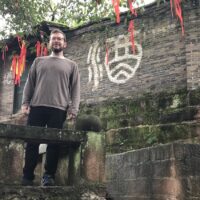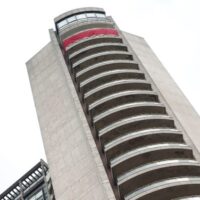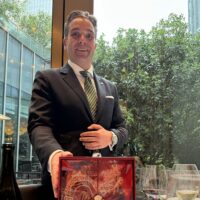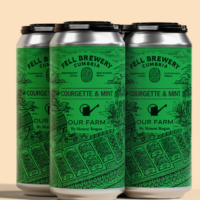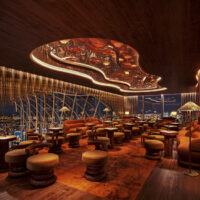Michael Seresin is the owner of Pinot Noir focused, biodynamically farmed Seresin Estate in Marlborough, which he founded in 1992. Born in Wellington in 1942, Seresin left his homeland in 1966 for the UK to pursue his dream of becoming a cinematographer. After a stint of filming car commercials and working on The Beatles’ Magical Mystery Tour, Seresin’s career took off after he collaborated with director Alan Parker on Bugsy Malone and Midnight Express. More recently he teamed up with Mexican director Alfonso Cuarón, working as the director of photography on Harry Potter and the Prisoner of Azkaban and Gravity. Based in London, he splits his time between the UK, New Zealand and his beloved Italy.

Was film something you were interested in as a child?
The first film to have an effect on me was The Third Man with Orson Wells, which I saw by mistake at a Saturday matinee on my eighth birthday. They were due to be playing a Randolph Scott western at my local cinema, so my mum gave me a shilling to go and see it, but instead of seeing a western the projectionist got his reels of film mixed up and I ended up watching The Third Man, which is a heavy duty movie for anyone, let alone an eight-year-old, but it was a brilliant film and I still love it.
How did you get into working in films?
While I was at university in Wellington I joined the film society. At the time New Zealand was quite socialist in a lot of ways (and sadly that’s gone), so I got exposed to a lot of Russian cinema, and films from Eastern Europe, France and Italy – it was the beginning of the ‘nouvelle vague’ in France and ‘neo realismo’ in Italy. I loved those films because they showed a slice of city life. I got into trouble at uni and only ended up staying two years. My old man had a friend called John O’ Shay who owned a little company called Pacific Films and I got a job there as a gopher and ended up shooting documentaries, commercials and two films.
What was your next step after your stint at Pacific Films?
I met an actress on one of the movies I worked on and we ended up getting married and moving to Rome. I didn’t really work while I was there but I absorbed Roman culture. I didn’t know anyone and I didn’t speak Italian, but the great thing about being in Rome was absorbing the street life. There was a little café in the Piazza del Poppolo I used to go to where all the film people used to hang out. It felt like being in a Fellini film compared to life in New Zealand, as Rome was the Hollywood of Europe in those days. To my 22-year-old self it was incredible and I felt very at home.

How did you get back into the industry?
I moved to the UK in 1966 and started working as a freelance as soon as I got into the union. I enjoyed the risk and the danger of it. There was a really good spirit back then, and in 1968 I worked on The Beatles’ Magical Mystery Tour as a camera assistant. Then I got introduced to a guy who ran a company that made adverts and worked my way up with him to being a cinematographer.
I was very fortunate to do very well very quickly. I directed a load of car commercials for Volkswagen and Renault; they were mini films shot in Europe that told a story. The budgets were huge for them. The lovely thing about it was that there was a huge amount of trust, which paid off creatively.
What was the film that launched your career?
I did two films with Alan Parker, Bugsy Malone and Midnight Express, which helped launch my career. Bugsy isn’t my favourite film – it’s an all studio film and I’m not a fan of those. I prefer darker dramatic stuff.
Midnight Express in terms of reputation did a lot more for me than Bugsy. I was young, around 29, and being given millions of bucks by studios to make big location movies – there was an incredible camaraderie among the key people on the films and we worked hard.
How is technology changing the film making process?
With digital you can shoot in colour then turn it black-and-white if that’s the look you want. The last few films I’ve done digitally, starting with Gravity. The choice of film versus digital isn’t mine – I can discuss it with the director but ultimately the decision is a financial one.
Film has something tangible about it – it’s a physical process. In the end as long as the film gets made it doesn’t really matter what it’s shot on. I would rather shoot on film but I’m not going to turn down a digital project as a matter of principal.
How would you describe your style as a cinematographer?
Filmmaking is a very mechanical process and my job is to story tell moving images as minimally as possible without interrupting the actors. Some cinematographers are much more demanding. I rarely ask an actor to do something for me. I did it once with Al Pacino and he said no. I asked him to keep his chin up a little while working on a film called City Hall, but he said he couldn’t do it for his character in that particular scene. I liked the challenge and we made it work.
Are you essentially painting with light?
To say I paint with light sounds pretentious but I do. I always look at the light I’ve got to work with – today there’s a soft skylight. It’s not sunlight, it’s north light like in a painter’s studio; reflective soft shadowless light. I like that – it has a nice feel to it dramatically. If I was shooting on a set then I would try to recreate something like this, unless I needed harsh shadows because I love shadows and darkness.
Darkness is more interesting than light because it feeds an audience’s imagination if you can’t quite see something. I’ve been nicknamed the prince of darkness because my stuff is pretty dark. The hardest part of my job is the justification of a light source. I always ask myself what would be giving me the light here – is it moonlight or a street light or the general ambient light of a city…
What is your favourite lens to shoot with?
There’s a part of me that likes using long lenses as an observer. I like Leica lenses a lot. Cuarón likes super wide-angle lenses, which is a huge challenge because his cameras are moving all the time. We did scenes on Gravity when the camera was moving 180 degrees, so where am I going to put the lights? We order around 10 lenses per film and probably end up only using four of them. I like working with a 35mm. That and 50mm are the conventional lenses as it’s what we as humans see. We shot close up for Midnight Express.
Interview continues on the next page…
